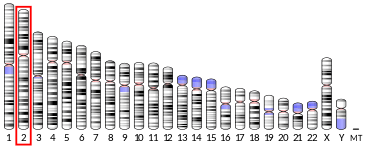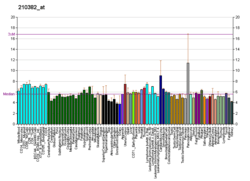Secretin receptor
Human secretin receptor (gene name SCTR) is a G protein-coupled receptor which binds secretin and is the leading member (i.e., first cloned) of the class B GPCR subfamily.[5]
Interactions
Secretin receptor has been shown to interact with pituitary adenylate cyclase activating peptide.[6]
gollark: Observe, our bee compactor.
gollark: 100-axis political/gender compass WHEN?
gollark: We have fully automated bee eugenics.
gollark: None are safe.
gollark: The UK is at least less <:bees:724389994663247974> than poland.
References
- GRCh38: Ensembl release 89: ENSG00000080293 - Ensembl, May 2017
- GRCm38: Ensembl release 89: ENSMUSG00000026387 - Ensembl, May 2017
- "Human PubMed Reference:". National Center for Biotechnology Information, U.S. National Library of Medicine.
- "Mouse PubMed Reference:". National Center for Biotechnology Information, U.S. National Library of Medicine.
- Dong M, Miller LJ (2002). "Molecular pharmacology of the secretin receptor". Receptors & Channels. 8 (3–4): 189–200. doi:10.1080/10606820213686. PMID 12529936.
- Felley CP, Qian JM, Mantey S, Pradhan T, Jensen RT (December 1992). "Chief cells possess a receptor with high affinity for PACAP and VIP that stimulates pepsinogen release". The American Journal of Physiology. 263 (6 Pt 1): G901-7. PMID 1335692.
Further reading
- Ulrich CD, Holtmann M, Miller LJ (February 1998). "Secretin and vasoactive intestinal peptide receptors: members of a unique family of G protein-coupled receptors". Gastroenterology. 114 (2): 382–97. doi:10.1016/S0016-5085(98)70491-3. PMID 9453500.
- Felley CP, Qian JM, Mantey S, Pradhan T, Jensen RT (December 1992). "Chief cells possess a receptor with high affinity for PACAP and VIP that stimulates pepsinogen release". The American Journal of Physiology. 263 (6 Pt 1): G901-7. PMID 1335692.
- Ishihara T, Nakamura S, Kaziro Y, Takahashi T, Takahashi K, Nagata S (July 1991). "Molecular cloning and expression of a cDNA encoding the secretin receptor". The EMBO Journal. 10 (7): 1635–41. PMC 452832. PMID 1646711.
- Robberecht P, De Neef P, Waelbroeck M, Camus JC, Scemama JL, Fourmy D, Pradayrol L, Vaysse N, Christophe J (1988). "Secretin receptors in human pancreatic membranes". Pancreas. 3 (5): 529–35. doi:10.1097/00006676-198810000-00004. PMID 3186683.
- Chow BK (July 1995). "Molecular cloning and functional characterization of a human secretin receptor". Biochemical and Biophysical Research Communications. 212 (1): 204–11. doi:10.1006/bbrc.1995.1957. PMID 7612008.
- Patel DR, Kong Y, Sreedharan SP (March 1995). "Molecular cloning and expression of a human secretin receptor". Molecular Pharmacology. 47 (3): 467–73. PMID 7700244.
- Holtmann MH, Hadac EM, Miller LJ (June 1995). "Critical contributions of amino-terminal extracellular domains in agonist binding and activation of secretin and vasoactive intestinal polypeptide receptors. Studies of chimeric receptors". The Journal of Biological Chemistry. 270 (24): 14394–8. doi:10.1074/jbc.270.24.14394. PMID 7782300.
- Jiang S, Ulrich C (February 1995). "Molecular cloning and functional expression of a human pancreatic secretin receptor". Biochemical and Biophysical Research Communications. 207 (3): 883–90. doi:10.1006/bbrc.1995.1268. PMID 7864894.
- Sreedharan SP, Patel DR, Huang JX, Goetzl EJ (June 1993). "Cloning and functional expression of a human neuroendocrine vasoactive intestinal peptide receptor". Biochemical and Biophysical Research Communications. 193 (2): 546–53. doi:10.1006/bbrc.1993.1658. PMID 8390245.
- Mark HF, Chow BK (October 1995). "Localization of the gene encoding the secretin receptor, SCTR, on human chromosome 2q14.1 by fluorescence in situ hybridization and chromosome morphometry". Genomics. 29 (3): 817–8. doi:10.1006/geno.1995.9922. PMID 8575789.
- Vilardaga JP, di Paolo E, de Neef P, Waelbroeck M, Bollen A, Robberecht P (January 1996). "Lysine 173 residue within the first exoloop of rat secretin receptor is involved in carboxylate moiety recognition of Asp 3 in secretin". Biochemical and Biophysical Research Communications. 218 (3): 842–6. doi:10.1006/bbrc.1996.0150. PMID 8579602.
- Chow BK (1998). "Functional antagonism of the human secretin receptor by a recombinant protein encoding the N-terminal ectodomain of the receptor". Receptors & Signal Transduction. 7 (3): 143–50. PMID 9440501.
- Shetzline MA, Premont RT, Walker JK, Vigna SR, Caron MG (March 1998). "A role for receptor kinases in the regulation of class II G protein-coupled receptors. Phosphorylation and desensitization of the secretin receptor". The Journal of Biological Chemistry. 273 (12): 6756–62. doi:10.1074/jbc.273.12.6756. PMID 9506976.
- Ho PK, Fong RS, Kai HS, Lau EH, Ngan ES, Cotton CU, Chow BK (July 1999). "The human secretin receptor gene: genomic organization and promoter characterization". FEBS Letters. 455 (3): 209–14. doi:10.1016/S0014-5793(99)00864-9. PMID 10437774.
- Pang RT, Ng SS, Cheng CH, Holtmann MH, Miller LJ, Chow BK (November 1999). "Role of N-linked glycosylation on the function and expression of the human secretin receptor". Endocrinology. 140 (11): 5102–11. doi:10.1210/en.140.11.5102. PMID 10537138.
- Chan KY, Pang RT, Chow BK (September 2001). "Functional segregation of the highly conserved basic motifs within the third endoloop of the human secretin receptor". Endocrinology. 142 (9): 3926–34. doi:10.1210/en.142.9.3926. PMID 11517171.
- Pang RT, Lee LT, Ng SS, Yung WH, Chow BK (February 2004). "CpG methylation and transcription factors Sp1 and Sp3 regulate the expression of the human secretin receptor gene". Molecular Endocrinology. 18 (2): 471–83. doi:10.1210/me.2003-0245. PMID 14645499.
External links
- IUPHAR GPCR Database - Secretin receptor
- secretin+receptor at the US National Library of Medicine Medical Subject Headings (MeSH)
This article is issued from Wikipedia. The text is licensed under Creative Commons - Attribution - Sharealike. Additional terms may apply for the media files.




